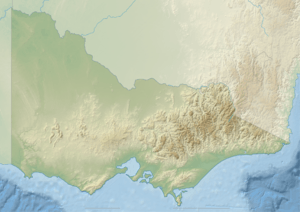Curdies River
| Curdies | |
| River[1] | |
| Country | Australia |
|---|---|
| State | Victoria |
| Regions | South East Coastal Plain (IBRA), The Otways |
| Local government area | Corangamite Shire |
| Part of | Corangamite catchment |
| Tributaries | |
| - left | Burnip Creek, Power Creek, Fenton Creek, Scotts Creek (Victoria), Spring Creek (Victoria) |
| - right | Abecketts Creek |
| Source | Otway Ranges |
| - location | Tandarook |
| - elevation | 92 m (302 ft) |
| - coordinates | 38°19′17″S 143°6′38″E / 38.32139°S 143.11056°E |
| Mouth | Great Australian Bight |
| - location | Curdies Inlet, Peterborough |
| - elevation | 0 m (0 ft) |
| - coordinates | 38°36′19″S 142°52′54″E / 38.60528°S 142.88167°ECoordinates: 38°36′19″S 142°52′54″E / 38.60528°S 142.88167°E |
| Length | 66 km (41 mi) |
| National park | Port Campbell National Park |
 Location of the Curdies River mouth
in Victoria | |
| [1][2] | |
The Curdies River is a perennial river of the Corangamite catchment, located in The Otways region of the Australian state of Victoria.
Location and features
The Curdies River rises below the settlement of Tandarook in southwest Victoria, east of the settlement of Cobden and flows generally south by west, joined by six minor tributaries through the Port Campbell National Park, before reaching its river mouth and emptying into the Great Australian Bight at Curdies Inlet, at the settlement of Peterborough. From its highest point, the Curdies River descends 92 metres (302 ft) over its 66-kilometre (41 mi) course.[2]
See also
References
- ↑ 1.0 1.1 "Curdies River: 2153". Vicnames. Government of Victoria. 2 May 1966. Retrieved 3 June 2014.
- ↑ 2.0 2.1 "Map of Curdies River, VIC". Bonzle Digital Atlas of Australia. Retrieved 3 June 2014.
External links
- "Great Otway National Park". Parks Victoria. Government of Victoria. 2014.
- "Corangamite Catchment Management Authority". Government of Victoria. 2014.
| ||||||||||